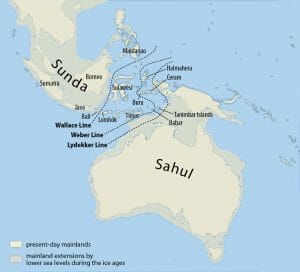Biogeography is the study of the distribution of species on Earth in the past and present, and how the distribution is effected by abiotic factors such as habitat, climate and terrain. The field is divided into three disciplines of biogeography: historical, ecological and conservation.
Historical biogeography is also called paleobiogeography and studies species distribution now as it relates to distribution in the past. Ecological biogeography examines the distribution of species in relation to biotic and abiotic factors in the environment. Finally, conservation biogeography is a relatively new field of biogeography which combines the study of conservation with biogeography to try and anticipate future conditions so that planning can be done to protect the biodiversity on Earth.
Examples of Biogeography
Australia
The continent of Australia provides excellent examples of how the isolation of land masses effects the distribution of species. About 75% of all the species of plants and animals in Australia are unique to that continent. The kangaroo, koala bear and wallaby are found only in Australia and are the result of the breakup and continental drift of the landmass Pangea that began about 200 million years ago. Also, the isolation of Australia has resulted in an abundance of marsupials and a scarcity of mammals.
The Influence of Mountains, Valleys and Rivers
British naturalist and explorer Alfred Russel Wallace traveled to the Amazon Basin and the Malay Archipelago in the mid-1800’s to study how and why the flora and fauna were distributed. He had a particular interest in how the presence and absence of natural geographic barriers like rivers, valleys and mountains had on the distribution of the species of butterflies and birds. He found that because of the separation created by the Amazon river, valleys and mountains, closely related species were often found on either side of these barriers. In addition, he found stark differences in the species found on either side of what came to be called the Wallace Line. Because of his dedication and the extensive knowledge obtained through his work, Wallace is known as the Father of Biogeography.
The Influence of Climate
Desert areas on Earth contain plants and animals that are adapted to hot and dry climate conditions. Plants like cactuses have thick fleshy leaves and waxy coatings that help them retain water and animals like the camel store fat in the humps on their backs. This fat acts not only as an insulator and food storage area, but also a water reservoir that camels can access through beta oxidation of the stored fat. If a desert species tries to expand into an area with a different climate, it will not survive. An example of this is shown by no alligators living in central North America. Climate is an abiotic factor that effects the distribution of alligators on the planet.

The image above shows the Wallace Line, named after Alfred Russel Wallace, a mid-19th-century British naturalist and explorer who discovered stark differences in the species found on either side of the line. The line falls on the continental shelf between Asia and Australia that began to separate about 50 million years ago.
References
- Alfred Russel Wallace. (n.d.). In Wikipedia. Retrieved July 3, 2017 from https://en.wikipedia.org/wiki/Alfred_Russel_Wallace
- Biogeography. (3 July, 2017). In Encyclopedia.Com Online. Retrieved from http://www.encyclopedia.com/earth-and-environment/geology-and-oceanography/geology-and-oceanography/biogeography
Biogeography Examples
No comments:
Post a Comment